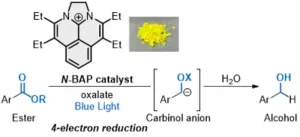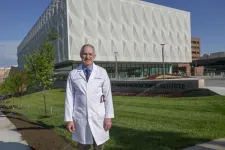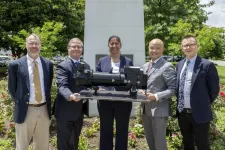Reduction of esters by a novel photocatalyst
2024-06-15
(Press-News.org)
The sweet smell of strawberries and other fruits is thanks to a chemical compound called ester, which is also found in many fats and polyesters. The ubiquitous compound can be broken down to produce desirable alcohols and other chemicals for use across industries including pharmaceuticals and cosmetics, but the process can be costly, both financially and in terms of the environment.
Now, a team of researchers with the National Institutes of Natural Sciences (NINS) in Japan has developed a novel approach using light as an energy source. They published their findings on June 14 in the Journal of the American Chemical Society.
In a seemingly counterintuitive move, to break down — or reduce, in the chemical parlay — esters, scientists actually add electrons to the compound. The addition of electrons forces the groups comprising the ester to reduce to more basic components. The conventional methods for ester reduction require excess amount of highly reactive and difficult to handle metal reductants.
Now, researchers are investigating the use of sustainable photocatalysts. Photocatalysts or catalysts that activate when excited by light, are known to promote an electron transfer process between the catalyst and organic compounds without using the highly reactive metal reductants. Conventional photocatalysts, involving expensive and non-renewable noble metals, reduces the limited organic compounds, and typically add only one electron to the compounds. Called single-electron transfer (SET), the process must proceed multiple times until the desired number of electrons are added to achieve the target reduction of esters.
“During the last decade, photocatalytic reactions have gained significant attention as desirable methods suitable for the United Nations’ Sustainable Development Goals (SDGs) in organic synthesis,” said co-corresponding author Shintaro Okumura, assistant professor at the Institute for Molecular Science (IMS) of NINS. “Photocatalysts promote redox reactions using visible light as an energy source in the absence of metal reductants. However, photocatalytic reactions through a multielectron transfer process have been less developed, so photocatalytic reduction of esters to form alcohols, which requires four electrons, has remained undeveloped. The photocatalytic reduction of esters to form alcohols is a formidable challenge because it requires an unprecedented successive quadruple SET process,” Okumura said.
To achieve this quadruple SET process, the researchers developed a novel photocatalyst they dubbed “N-BAP.” When irradiated with blue light, the photocatalyst initiates the reaction to produce a chemical group that reacts with water and a second carbon-based chemical group. With the addition of oxalate, a negatively charged molecule found widely in nature, the reaction can add four electrons in quick succession — resulting in the desired alcohols.
“The combination of N-BAP catalyst with oxalate as a traceless reductant permits the rapidly sequential four-electron reduction of esters to generate carbinol anions, with subsequent protonation to give alcohols,” Okumura said. “This work could pave the novel transformation of esters and is expected to contribute to a sustainable society as a green organic synthesis suitable for the SDGs.”
Okumura is also affiliated with. Other contributors include co-corresponding author Yasuhiro Uozumi, Shusuke Hattori and Lisa Fang, all affiliated with IMS. Okumura, Uozumi and Hattori are also affiliated with the Department of Functional Molecular Science at The Graduate University for Advanced Studies, also known as SOKENDAI.
The Japan Science and Technology Agency and the Japan Society for the Promotion of Science funded this research.
Information of the paper:
Authors: Shintaro Okumura, Shusuke Hattori, Lisa Fang, Yasuhiro Uozumi
Journal Name: Journal of the American Chemical Society
Journal Title: “Multielectron Reduction of Esters by a Diazabenzacenaphthenium Photoredox Catalyst”
DOI: 10.1021/jacs.4c05272 (open access)
Financial Supports:
ACT-X, Japan Science and Technology Agency: JPMJAX23D6
Grant-in-Aid for Transformative Research Areas(A): JP24H01873
Grant-in-Aid for Early-Career Scientists: JP24K17688
Contact Person:
Shintaro Okumura
TEL/FAX: +81-75-383-2753 / +81-75-383-2748-
E-mail: okumura.shintaro.6e_at_kyoto-u.ac.jp (Please replace the "_at_" with @)
Yasuhiro Uozumi
TEL/FAX: +81-564-59-5571 / +81-564-59-5574}
E-mail: uo_at_ims.ac.jp (Please replace the "_at_" with @)
END
[Attachments] See images for this press release:

ELSE PRESS RELEASES FROM THIS DATE:
2024-06-15
As temperatures rise, so do chances for migraine attacks, according to a new study from a team of researchers at the University of Cincinnati College of Medicine, Icahn School of Medicine at Mount Sinai, Errex Inc. and Teva Pharmaceuticals USA. Inc.
“Weather change is one of the most common trigger factors for migraine,” says Vincent Martin, MD, director of the Headache and Facial Pain Center at UC's Gardner Neuroscience Institute and UC Health physician. He is the study’s lead author and president of the National Headache Foundation.
These findings from the study, which looked at use of Fremanezumab and whether it could prevent headaches ...
2024-06-15
Cyanobacteria are one of the oldest and most important life forms in the world – for example as they took an essential part in producing the oxygen in our atmosphere. Some types form long filaments composed of a few to more than 1,000 individual cells. In this form, the filamentous bacteria can move around. The principles of this locomotion have now been investigated by a research team led by Stefan Karpitschka, group leader at the MPI-DS and professor at the University of Konstanz, in collaboration with the University of Bayreuth and the University of Göttingen.
"We measured the force during locomotion on individual ...
2024-06-15
Omics analysis is the process of analyzing large data sets to extract meaningful information about biological molecules—genes, DNA, RNA, proteins, metabolites or more—with the goal of illuminating typical molecular pathways and deciphering where things go awry in disease. In a study led by Bruno A. Benitez, MD, a human geneticist and director of the Neurobiorepository in the department of Neurology at Beth Israel Deaconess Medical Center (BIDMC), investigators used machine learning approaches to integrate high-throughput transcriptomic, proteomic, metabolomic, and lipidomic profiles to provide novel ...
2024-06-15
In a new paper, researchers from Carnegie Mellon University and Stevens Institute of Technology show a new way of thinking about the fair impacts of AI decisions.
They draw on a well-established tradition known as social welfare optimization, which aims to make decisions fairer by focusing on the overall benefits and harms to individuals. This method can be used to evaluate the industry standard assessment tools for AI fairness, which look at approval rates across protected groups.
"In assessing fairness, the AI community tries to ensure equitable treatment for groups that differ in economic level, ...
2024-06-14
WASHINGTON – U.S. Naval Research Laboratory scientists and engineers received the prestigious Department of Navy Dr. Delores M. Etter Top Scientists and Engineers of the Year Award, June 12, during an awards ceremony hosted at the Pentagon.
“The Top Scientists and Engineers of the Year award program recognizes and acknowledges the excellence of our highest performing scientists and engineers in support of the Department of the Navy," said Frederick J. Stefany, Assistant Secretary of the Navy for Research, ...
2024-06-14
Waltham — June 14, 2024 — When implemented in Nebraska, the WISEWOMAN program supported by the Centers for Disease Control and Prevention (CDC), which offers services for women ages 40–64 who are low-income and uninsured/underinsured, improved hypertension, blood pressure self-management, diet, physical activity, and body weight. Jianping Daniels, PhD and colleagues, of the Nebraska Department of Health and Human Services, detail these findings in a supplement to the Journal of Public Health Management and Practice, published in the Lippincott portfolio by Wolters Kluwer.
In an introduction ...
2024-06-14
Researchers have presented the latest findings from a clinical trial aimed at discovering a cure for sickle cell disease, a painful genetic blood disorder with limited treatment options.
Conducted as part of the multicenter RUBY Trial, researchers shared data on the safety and effectiveness of renizgamglogene autogedtemcel (reni-cel, formerly known as EDIT-301), an experimental one-time gene editing cell therapy, among its 18 patients at the European Hematology Association 2024 Hybrid Congress (EHA) in Madrid, Spain.
This innovative treatment modifies a patient’s own blood-forming stem cells ...
2024-06-14
CAMBRIDGE, MA - Large language models like those that power ChatGPT have shown impressive performance on tasks like drafting legal briefs, analyzing the sentiment of customer reviews, or translating documents into different languages.
These machine-learning models typically use only natural language to process information and answer queries, which can make it difficult for them to perform tasks that require numerical or symbolic reasoning.
For instance, a large language model might be able to memorize and recite a list of recent U.S. presidents and their birthdays, but that same model could fail if asked the question “Which U.S. presidents elected after 1950 ...
2024-06-14
Residential treatment is among the most effective tools for treating substance use disorder, with people in these settings showing improvement not only in their substance use but also in their mental health, social functioning and quality of life. However, when people leave residential substance use facilities, they face immense challenges as they attempt to reintegrate into their communities and return to their normal lives.
As many as 40 to 70 percent of people who complete residential treatment return ...
2024-06-14
CRISPR/Cas9 gene editing has made possible a multitude of biomedical experiments including studies that systematically turn off genes in cancer cells to look for ones that the cancer cells heavily depend on to survive and grow. These genes, or “cancer dependencies,” are often promising drug targets. But new research shows that many of these CRISPR screening experiments rely on components, called CRISPR/Cas9 guides, that do not perform equally well in cells from people of all ancestries, which can cause CRISPR screens to miss cancer dependencies.
These CRISPR guides are short sequences of RNA that ...
LAST 30 PRESS RELEASES:
[Press-News.org] Reduction of esters by a novel photocatalyst



